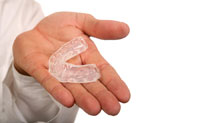Now that you have your braces in place, it is especially important to maintain good oral health throughout the length of your treatment. To get the most of your braces, and wear them for the shortest time with the fewest visits, keep your braces clean and be mindful of the foods you eat.

Brushing and Flossing with Braces
While wearing braces, the risk of gum disease and tooth decay is much higher as food and plaque can get trapped in the tiny spaces between brackets and wires, causing decay and enamel stains. To avoid dental problems and discoloration, it is best to brush after every meal and use special orthodontic floss at least once a day to clean between brackets and under wires. Check your teeth in a mirror to make sure all food particles have been washed away. If you don’t have your toothbrush with you, rinse your mouth vigorously with water. Ask our San Jose office about special cleaning aids, which are specially designed to clean between wires and appliances.
Eating with Braces
Patients can eat and drink most foods while wearing braces, but there are certain foods and habits that a patient should avoid to prevent bending wires, breaking brackets, and loosening the cement that attaches the appliances to your teeth.
- Avoid chewy and sticky foods, such as caramel, taffy, chewing gum and beef jerky which can stick to braces.
- Avoid hard foods, such as apples, pretzels, candies, nuts and popcorn which break wires and loosen brackets.
- Minimize sweets, soda and other sugary and starchy foods and drinks that promote decay.
- Refrain from habits such as pencil chewing, nail biting and picking at your wires as this can also lead to damaged braces.
Keep in mind that broken braces will require extra appointments and time. Make an appointment immediately if your wires and brackets are damaged so that your orthodontic treatment won’t be delayed.
Protecting Your Mouth
Any contact to the mouth could not only break or damage your braces, but it could seriously injure your teeth and gums. If this is a problem, a special wax is available, which is placed on the wires to prevent irritation of your oral tissues. When playing sports where there is a chance of getting struck in the mouth, wear a mouth guard. These durable mouth pieces fit over your braces and teeth to protect your mouth tissue from painful contact with your braces.
Caring for your braces will require a little more time and effort on your part, but is necessary to keep your teeth and gums healthy throughout treatment. Remember that your orthodontic care is only temporary, but your new, beautiful smile will last a lifetime!











